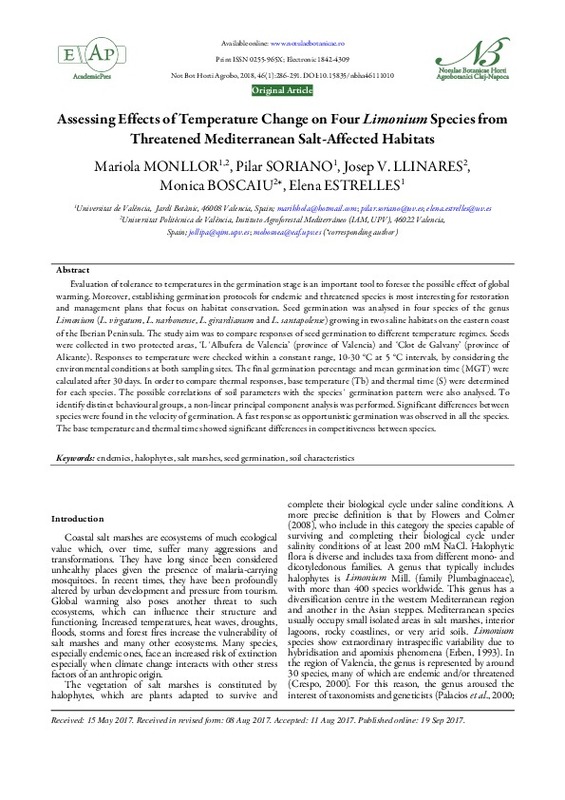JavaScript is disabled for your browser. Some features of this site may not work without it.
Buscar en RiuNet
Listar
Mi cuenta
Estadísticas
Ayuda RiuNet
Admin. UPV
Assessing Effects of Temperature Change on Four Limonium Species from Threatened Mediterranean Salt-Affected Habitats
Mostrar el registro sencillo del ítem
Ficheros en el ítem
| dc.contributor.author | Monllor, Mariola
|
es_ES |
| dc.contributor.author | Soriano, Pilar
|
es_ES |
| dc.contributor.author | Llinares Palacios, Josep Vicent
|
es_ES |
| dc.contributor.author | Boscaiu, Monica
|
es_ES |
| dc.contributor.author | Estrelles, Elena
|
es_ES |
| dc.date.accessioned | 2019-06-07T20:05:07Z | |
| dc.date.available | 2019-06-07T20:05:07Z | |
| dc.date.issued | 2018 | es_ES |
| dc.identifier.issn | 0255-965X | es_ES |
| dc.identifier.uri | http://hdl.handle.net/10251/121767 | |
| dc.description.abstract | [EN] Evaluation of tolerance to temperatures in the germination stage is an important tool to foresee the possible effect of global warming. Moreover, establishing germination protocols for endemic and threatened species is most interesting for restoration and management plans that focus on habitat conservation. Seed germination was analysed in four species of the genus Limonium (L. virgatum, L. narbonense, L. girardianum and L. santapolense) growing in two saline habitats on the eastern coast of the Iberian Peninsula. The study aim was to compare responses of seed germination to different temperature regimes. Seeds were collected in two protected areas, `L¿Albufera de Valencia¿ (province of Valencia) and `Clot de Galvany¿ (province of Alicante). Responses to temperature were checked within a constant range, 10-30 °C at 5 °C intervals, by considering the environmental conditions at both sampling sites. The final germination percentage and mean germination time (MGT) were calculated after 30 days. In order to compare thermal responses, base temperature (Tb) and thermal time (S) were determined for each species. The possible correlations of soil parameters with the species¿ germination pattern were also analysed. To identify distinct behavioural groups, a non-linear principal component analysis was performed. Significant differences between species were found in the velocity of germination. A fast response as opportunistic germination was observed in all the species. The base temperature and thermal time showed significant differences in competitiveness between species. | es_ES |
| dc.language | Inglés | es_ES |
| dc.publisher | AcademicPres (EAP) Publishing House | es_ES |
| dc.relation.ispartof | Notulae Botanicae Horti Agrobotanici Cluj-Napoca | es_ES |
| dc.rights | Reconocimiento (by) | es_ES |
| dc.subject | Endemics | es_ES |
| dc.subject | Halophytes | es_ES |
| dc.subject | Salt marshes | es_ES |
| dc.subject | Seed germination | es_ES |
| dc.subject | Soil characteristics | es_ES |
| dc.subject.classification | BOTANICA | es_ES |
| dc.subject.classification | EDAFOLOGIA Y QUIMICA AGRICOLA | es_ES |
| dc.title | Assessing Effects of Temperature Change on Four Limonium Species from Threatened Mediterranean Salt-Affected Habitats | es_ES |
| dc.type | Artículo | es_ES |
| dc.identifier.doi | 10.15835/nbha46111010 | es_ES |
| dc.rights.accessRights | Abierto | es_ES |
| dc.contributor.affiliation | Universitat Politècnica de València. Departamento de Química - Departament de Química | es_ES |
| dc.contributor.affiliation | Universitat Politècnica de València. Departamento de Ecosistemas Agroforestales - Departament d'Ecosistemes Agroforestals | es_ES |
| dc.description.bibliographicCitation | Monllor, M.; Soriano, P.; Llinares Palacios, JV.; Boscaiu, M.; Estrelles, E. (2018). Assessing Effects of Temperature Change on Four Limonium Species from Threatened Mediterranean Salt-Affected Habitats. Notulae Botanicae Horti Agrobotanici Cluj-Napoca. 46(1):286-291. https://doi.org/10.15835/nbha46111010 | es_ES |
| dc.description.accrualMethod | S | es_ES |
| dc.relation.publisherversion | http://doi.org/10.15835/nbha46111010 | es_ES |
| dc.description.upvformatpinicio | 286 | es_ES |
| dc.description.upvformatpfin | 291 | es_ES |
| dc.type.version | info:eu-repo/semantics/publishedVersion | es_ES |
| dc.description.volume | 46 | es_ES |
| dc.description.issue | 1 | es_ES |
| dc.relation.pasarela | S\387681 | es_ES |








